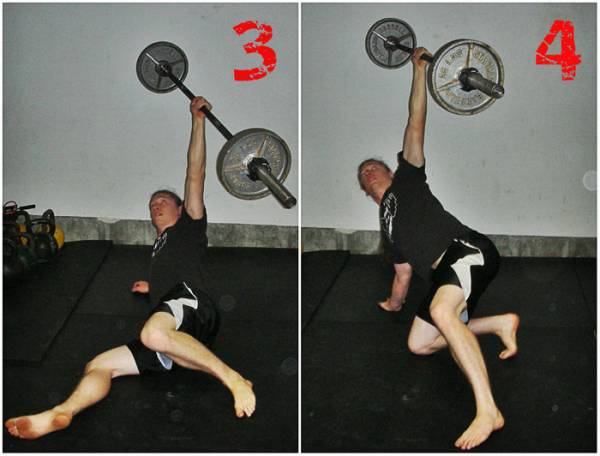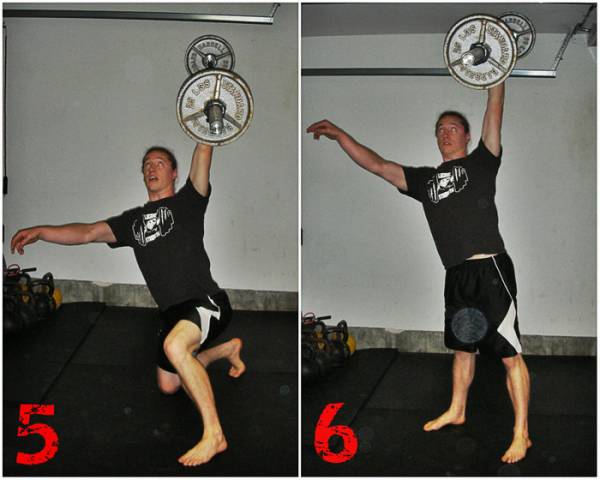I first got into doing the get up, also known as the Turkish get up, when I was introduced to kettlebells. This happened to also be my introduction to other great exercises like the bent press, windmill, and more.
Side note: I think many people fall in love with kettlebells not because of the tool so much, but because they end up doing far better exercises than what they had been doing previously with barbells and dumbbells, i.e. the standard commercial gym workouts.
The get up is one of those great exercises that accomplishes a lot in just this one movement. The basics of this exercise are to stand up while keeping a weight overhead the entire time. Often, this is then reversed and you get back down to the ground while still maintaining the weight overhead.
The Turkish get up as taught by the StrongFirst training method.
The Power of Overhead Movements
The word overhead is important. The weight really does stay “over your head,” but as your body shifts around, this overhead position is maintained by working the shoulder through a significant degree of motion. This is one of the reasons the get up helps in rehabbing shoulder problems for many people.
While the movement can be awkward when you first try it, once you are trained in the exercise you will be able to handle a good amount of weight. It is said that old-time strongman Sig Klein would have people at his gym train with the get up until they could handle 100 pounds before he would start them on other exercises. A hundred-pound getup is a solid goal worth shooting for!
“For the ultimate challenge, try working this movement with the barbell.”
As with the bent press, the get up can be done with a number of tools. The kettlebell tends to be the easiest and is the best starting place because the offset weight helps keep your arm in place. The kettlebell basically pulls back slightly, helping you to use your anatomical structure better.
Dumbbells are great, too, and provide a bit more challenge as the weight is slightly further away from you and thus at a worse leverage. But for the ultimate challenge, try working this movement with the barbell.
Experimenting With Equipment
If you have never done this exercise before, it’s worth giving it a shot. If you have done the movement with kettlebells or dumbbells, then I recommend you start experimenting with a barbell. When I got started with the barbell, I found that by changing the recommended form slightly I could handle more weight. My instructions for doing this follow.
- Start lying on the ground with the barbell to the side of you, but in line with your body.
- Roll over to one side, grasp the barbell with one hand and cup the other hand around your first hand. It is absolutely essential to grab the barbell in the middle. Specifically, put your middle finger directly in the center of the barbell. I use a piece of tape to indicate where this is so I can easily place my hand each time.
- Using both hands, push the barbell up into lockout over your body. The barbell should be parallel with your body.
- At this time, let go of the extra hand and maintain the weight over your head.
- Bend the leg that is on the same side as your lifting arm, so the knee is in the air and the foot flat on the ground.
- Roll to the non-barbell side, until you are on your side.
- Press into the ground with your free hand. You will scoot upward, making little movements at a time, until you come to a position where you are leaning against your elbow.
- From here extend the elbow so you are resting on your hand.
- Press using your leaning arm and your leg with your food flat on the ground (the same side as the weight), and raise up your hips just enough to get your leg pulled through. (With the kettlebell, get up you go through a high arch in this position. That is great for training movement quality, but when you’re working with a heavy barbell you’ll want to skip that added movement.)
- Come to a kneeling position in an action similar to a side raise, picking your leaning arm off the ground.
- Drive off with both feet coming to a standing position with the weight overhead.


From there, you can lower down in the same manner or simply drop the barbell. When working with the barbell, I usually just do the standing portion and don’t go back down. After you are done with one rep, begin once again on the other side.
Tips for a Successful Get Up
- Make sure to keep the lifting arm locked out at all times and your eyes on the barbell. As mentioned, this is much harder than the kettlebell version because of the balance involved.
- Be prepared to drop the barbell. But, of course, only train this in a suitable place for dropping weights. It is recommended to use bumper plates because you will likely drop during some attempts on this exercise.
- This is an exercise where I typically only do singles. Just do a few of them working up to a progressively heavier weight.
The get up fits in great as a skill-practice exercise done at the beginning of your workout before doing other movements. The last time I worked on this exercise regularly it essentially served as my entire warm up.
Give the get up a try and see what you think. It’s a great whole body exercise for developing good movement and challenging your strength. If you have questions, post them to the comments below.
Check out these related articles:
- The Get Up: Why It’s My Favorite Exercise
- How to Do the Perfect Get Up
- The Value of the Get Up (Broken Down Into 6 Pieces)
- What’s New On Pulse Beat Fit Today






